|
Books 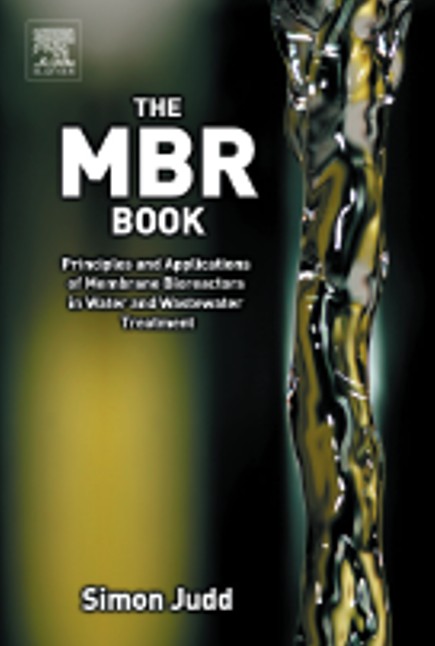
The MBR Book: Principles and Applications of Membrane Bioreactors for Water and Wastewater Treatment By Simon Judd, Head of Water Sciences and Chair in Membrane Technology, Cranfield University, UK Elsevier, July 2006: 234x156: 256pp, ISBN: 1856174816: £94.99 / €138.00 / $170.00 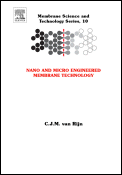
Nano and micro engineered membrane technology, 10 CJM van Rijn ISBN: 0-444-51489-9, Hardbound, 396 pages, publication date: 2004, ELSEVIER, Price: USD 185/GBP 123.50/EUR 185 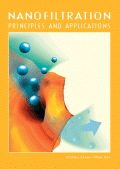
Nanofiltration, principles and applications A. Schaefer Hardbound, ISBN: 1-85617-405-0, 384 pages, publication date: 2004, ELSEVIER ADVANCED TECHNOLOGY, Price: GBP 95.50 / EUR 143 / USD 143 
Membranes for Industrial Wastewater Recovery and Re-Use Simon Judd and Brian Jefferson Elsevier, 2003 ISBN 1856173895, 256 Pages, Price USD 138 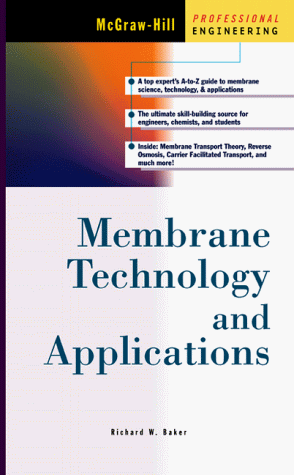
Membrane Technology and Applications (McGraw-Hill Professional Engineering) Richard W. Baker McGraw-Hill Companies, Dec.2000 ISBN 0071354409, 514 pages 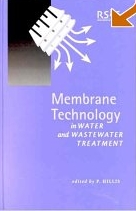
Membrane Technology in Water and Wastewater Treatment Ohya, H, Kudryavsev, V V, Semenova, S.I. Royal Society of Chemistry; 1st edition (May 15, 2000) ISBN 0854048006, 269 Pages, Price US$185 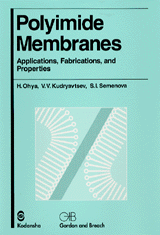
Polyimide Membranes, Applications, Fabrications and Properties Publisher: Taylor & Francis Ltd, 1997 ISBN 9056990241, Price £100.10 
Basic Principles of Membrane Technology Marcel Mulder Kluwer Academic Publishers, October 1996 ISBN 079234247X 
Water Treatment Membrane Processes Joel Mallevialle (Editor), Publisher: McGraw-Hill Education ISBN: 0070015597, Hardcover 320 pages (December 1995), Price: £72.99 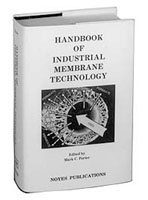
Handbook of Industrial Membrane Technology Mark C. Porter ISBN: 0-8155-1205-8, 604 pages, © 1990 Noyes, 6 x 9 Hardcover, Price $160 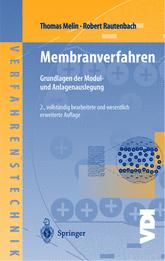
Membranverfahren, Grundlagen der Modul- und Anlagenauslegung Melin, Thomas, Rautenbach, Robert. 2., vollst. bearb. u. wesentl. erw. Aufl., 2004, XIV, 541 S. 223 illus., Geb. Reihe: VDI-Buch, Unterreihe: Chemische Technik / Verfahrenstechnik ISBN 3-540-00071-2, 541 Pages, Price EUR 99,95 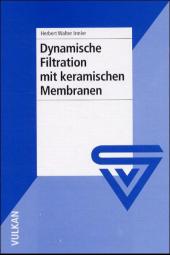
Dynamische Filtration mit keramischen Membranen Irmler , Herbert W. VULKAN, 2001. XVI, 367 S. m. Abb. 21,5 cm ISBN 3802728408 , 367 Pages, Price EUR 70,56 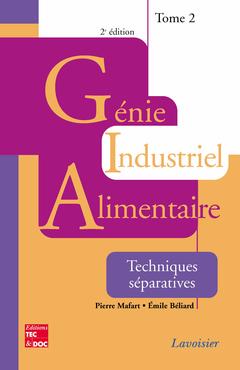
Génie industriel alimentaire Tome 2: Techniques séparatives (2° Ed.) MAFART Pierre, BÉLIARD Émile Lavoisier 11-2004, 274p. 15.5x24, Price EUR 46,- 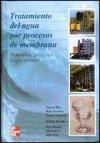
Tratamiento del agua por procesos de membrana A.W.W.A. (Editorial McGraw-Hill) ISBN: 8448112067, 864 p. ; 24x17 cm. 1ª edición (20-FEB-98), Precio:56,95 € 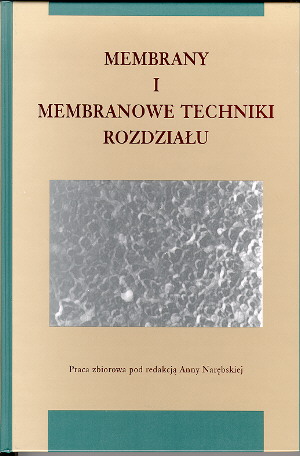
Membrany i membranowe techniki rozdzialu Anna Narebska (red.) ISBN 83-231-0937-0, ss. 330, twarda oprawa, 1997 Torun, wyd. 1 
The MBR Book: Principles and Applications of Membrane Bioreactors for Water and Wastewater Treatment By Simon Judd, Head of Water Sciences and Chair in Membrane Technology, Cranfield University, UK Elsevier, July 2006: 234x156: 256pp, ISBN: 1856174816: £94.99 / €138.00 / $170.00 The MBR Book covers all important aspects of Membrane BioReactors in water and waste water treatment, from the fundamentals of the processes via design principles to MBR technologies. Industrial case studies help interpret actual results and give pointers for best practice. Useful appendices provide data on commercial membranes and international membrane organisations. Contents: 1. Introduction: Historical Perspective and Drivers 2. Fundamentals: Membrane & Biological Processes; MBR Technology and Membrane Fouling 3. Design Principles: Design Parameters; Comparative Pilot Trials; Sample Design Calculations 4. MBR Technologies: Commercial MBR Systems; Membranes and MBR Processes 5. Case Studies: Municipal and Industrial Effl uent Treatment Reference Sites 
Nanofiltration, principles and applications A. Schaefer Hardbound, ISBN: 1-85617-405-0, 384 pages, publication date: 2004, ELSEVIER ADVANCED TECHNOLOGY, Price: GBP 95.50 / EUR 143 / USD 143 Description Nanofiltration processes are finding wide applications in several 'wet' industries, such as water/wastewater treatment, water re-use, textile industry, diary industry, food industry and the pulp and paper industries. Despite this, no definitive book exists which covers the principles of the techniques and their potential and actual applications. ' Nanofiltration: Principles and Applications ' is edited by three well-known specialists from Australia, and contains chapters from top international authorities. The result is a comprehensive and up to date account which will be essential reading for membrane designers, manufacturers and end-users worldwide. Audience Water engineers; membrane designers and manufacturers; end users of membranes in the food, beverage, textile, paper, waste water and potable water industries. Contents Chapter 1 Introduction; Chapter 2 History of nanofiltration membranes 1960 to 1990; Chapter 3 Nanofiltration membrane materials and preparation; Chapter 4 Module design and operation; Chapter 5 Membrane characterization; Chapter 6 Modelling the performance of Nanofiltration; membranes; Chapter 7 Chemical speciation effects in Nanofiltration separation; Chapter 8 Fouling in Nanofiltration; Chapter 9 Pretreatment and hybrid processes; Chapter 10 Water treatment; Chapter 11 Water reclamation, remediation and cleaner production with Nanofiltration; Chapter 12 Nanofiltration in the food industry; Chapter 13 Nanofiltration in the chemical processing industry; Chapter 14 Nanofiltration in the pulp and paper industry; Chapter 15 Nanofiltration of textile dye effluent; Chapter 16 Nanofiltration of landfill leachates treatment; Chapter 17 Nanofiltration bioreactors; Chapter 18 Photocatalytic nanofiltration reactors; Chapter 19 Nanofiltration in metal and acid recovery; Chapter 20 Trace contaminant removal with Nanofiltration; Chapter 21 Non?aqueous applications of Nanofiltration; Chapter 22 Conclusion; Index. 
Nano and micro engineered membrane technology, 10 CJM van Rijn ISBN: 0-444-51489-9, Hardbound, 396 pages, publication date: 2004, ELSEVIER, Price: USD 185/GBP 123.50/EUR 185 Description: This book is about Nano and micro engineered membrane technology, an emerging new technological area in membrane technology. Potential applications cover a broad spectrum of science, such as micro and nano filtration, gas separation, optics and nanophotonics, catalysis, microbiology, controlled drug delivery, nanopatterning, micro contact printing, atomisation, cross flow emulsification, etc. A brief overview of filtration membranes and pore structures is presented in chapter 1 and in the subsequent chapter 2 an overview is presented of conventional micro perforation methods, like laser drilling, electroforming, precision etching etc. With micro engineering techniques (chapter 3), originating from the semiconductor industry, it is relatively easy to downscale and form submicron pores (down to 100 nm) using photolithographic methods, with e.g. contact masks and wafer steppers. In chapter 4 some elementary fluid mechanics related to fluid flow in conducts and single and multiple orifices is presented covering analytical methods as well as computational fluid dynamics. Much effort has been put in strength and maximum pressure load analysis (chapter 5) of perforated and unperforated membranes. New analytical expressions were obtained that were verified by a number of computer simulations and many experiments. A separate chapter (chapter 6) has been devoted to the pioneering work of manufacturing polymeric perforated membranes because of its potential future economical impact. Large scale microfiltration applications on e.g. skim milk and lager beer are presented in chapter 7, whereas in chapter 8 a micro scale Lab-on-a-Chip microfiltration/fractionation demonstrator is discussed. Nanotechnology and nano engineered membranes is the fascinating topic of chapter 9, with typical examples as nanopatterning, nanophotonics and nanomembrane technology. This book closes with novel pioneering applications on atomization (chapter 10) for deep pulmonary inhale and cross flow emulsification (chapter 11) for the manufacturing of e.g. functional foods and nano/micro emulsions. Audience: Industry consultants and individual scientists in the area of chemical engineering, physical chemistry, membrane technology, and material science. Contents Overview Membrane Technology: - Membrane Processes - Filtration through size exclusion - Separation by solution-diffusion process - Separation by charge - Membrane Structures - Ceramic membranes - Polymeric membranes - Nanocomposite membranes - Other membrane structures Microperforation Methods: - Wet etching of perforations in metal foils - Electroforming of perforations - Electro perforation - Laser cutting and drilling of perforations - Hot embossing Micro Engineered Membranes: - Introduction micro engineering - MEMS Silicon micro engineering - Micro engineered unperforated membranes - Micro engineered perforated membranes - Semiconductor lithography - Laser interference lithography - Device fabrication with short exposure time - Short versus long exposure times - Fabrication of microsieves with silicon wafers - Wet etching through the pores - Silicon Wafers Fluid Mechanics: - Fluid flow through a channel and an orifice - Flow through rectangular and circular orifices Membrane Deflection and Maximum Pressure Load: - Analytical pressure load expressions - Experiments - Perforated membranes and maximum pressure load Polymeric Membranes: - Photolithographic polyimide membranes - Hot moulding techniques - Phase separation micro moulding - Moulding of micro array and a microwell - Flat sheet and tubular polymeric structures - Capillary polymeric structures Microfiltration: - Cross flow microfiltration of large particles - Cross flow microfiltration of polydisperse suspensions - Microfiltration of lager beer - Micro filtration and fractionation of milk - Microfiltration of blood-cell concentrates - Microscreens for rapid microbiological detection Lab and Fab-on-a-Chip - Lab-on-a-Chip for particle fractionation - Fab-on-a-Chip for de-hydrogenation process Nanotechnology and Nano Engineered Membranes - Introduction Nanotechnology - Zeolites, self assembled molecular sieves - Molecular sieves on siliconnitride membranes Patterning of nanostructures - Stencilling with nanosieves - Nanosieves for Photonic Structures - Silicon nitride photonic crystals - Alumina photonic crystals - Nano membrane separation technology - Nano engineered biomembranes - Biosensors Nanotubes - Carbon nanotubes - Templated nanotubes and nanofiltration - Nano printing and etching Atomisation - Introduction theory - Atomisation with micro machined nozzles Membrane Emulsification - CFD and membrane emulsification - Analytical cross-flow emulsification model 
Handbook of Industrial Membrane Technology Mark C. Porter ISBN: 0-8155-1205-8, 604 pages, © 1990 Noyes, 6 x 9 Hardcover, Price $160 DESCRIPTION Discusses theory, engineering aspects, membrane preparation and applications for the use of synthetic membranes in separations involving industrial or municipal process streams. Chapters are written by the world's leading experts in the field of membrane science and technology. CONTENTS Synthetic Membranes and Their Preparation Microfiltration Ultrafiltration Reverse Osmosis Thin Film Composite Reverse Osmosis Membranes Process Design, Optimization Enzyme Membrane Reactors and Membrane Fermentors Electrodialysis Coupled Transport Membranes Separation of Gases by Membranes 
Membranes for Industrial Wastewater Recovery and Re-Use Simon Judd and Brian Jefferson Elsevier, 2003 ISBN 1856173895, 256 Pages, Price USD 138 This new book is a comprehensive account of the use of membrane technology in the cleaning of industrial water. It covers the principles, mechanisms, applications and case histories from important industrial users. There is increasing political and environmental pressure on industry to clean up the water which it uses in many processes, and to re-use this water where possible. This cleaning is done using specially-developed industrial membranes and this book covers the types and design of membranes, how they work and in which industries they are used. Special attention is paid to the textile, food/ beverage, pharmaceutical, oil and pulp and paper industries where such membranes are in regular use. Contents Chapter 1 - Introduction Water reuse motivations and barriers - Industrial water, - Membrane technology Chapter 2 - Membrane technology The membrane, Membrane and membrane process definition Membrane structure - Membrane materials and their manufacture - Membrane configurations - The process fundamentals - Process performance definitions - The driving force - Factors opposing the driving force - Critical flux - The theory - Membrane mass transfer control - Fouling/cake layer mass transfer control - Process design and operation - Staging - Specific energy demand - Fouling and pretreatment - Backwashing and cleaning - References Chapter 3 - Industrial Waters 3.1 The power industry:water requirements for power generation and cooling water Water demand by the power industry - Overview of cooling water systems - Overview of boiler feedwater systems - Sources of water used for - Water quality comparisons - Optimisation of water use in recirculating cooling systems - Cooling tower water quality issues - Governing legislation and guidelines - Volumes and quality of aqueous process waster streams - Current reuse practices and opportunities - References 3.2 The pulmp and paper industry Introduction - Pulping and paper manufacturing processes - Effluent volumes and quality - Current water and effluent purification systems and governing legislation - Membranes in the pulp and paper industry - Conclusions - Acknowledgements - References The textile industry Categories of textile processing operations - Process water quality requirements - Legislation - Conventional treatment - Demand management - Reuse practice and opportunities - References 3.4 The beverage industry Point of use recycling opportunities - End of pipe recovery opportunities - References 3.5 Pure waters in the pharmaceutical industry Background - Water quality standards - Volumes and quality of aqueous process and waste streams - Reuse opportunities Chapter 4 - System design aids 4.1 Computer-aided design for reverse osmosis plant Introduction - Key elements of the reverse osmosis process - RO design software - Cost calculation - Overview - References 4.2 Water pinch analysis - Introduction - Water pinch: the history - Methodology - Computed solutions - Software tools currently available - Case study: water pinch and implementation of regeneration techniques - Conclusion - References 4.3 Design examples - Problem in reverse osmosis: film theory and energy demand - Problem in reverse osmosis: array design - Problem in reverse osmosis: CAD array design - Problem in electrodialyis: energy demand - Problem in submerged membrane filtration design Chapter 5 - Case Studies 5.1 Flag Fen high-purity water production plant (UK) Background - Description of plant - Performance 5.2 Eraring Power Station: purification of secondary sewage for boiler feedwater (Australia) - Background - Description of plant - Performance 5.3 Doswell combined cycle power plant: zero liquid discharge (USA) Background - Description of system - Performance 5.4 VHP Ugchelen: paper mill water recycling (Netherlands) - Background - Description of system - Performance 5.5 Kronospan Ltd: medium-density fibreboard wash water recycling (UK) Background - Description of plant - Performance 5.6 M-Real Kirkniemi paper mill (England) Background - Description of plant - Performance 5.7 T. Forsell and Son: dyewaste water recycling plant (UK) - Background - Description of plant - Performance 5.8 N food plant wasterwater treatment and recycling plant (Japan) Background - Description of plant - Performance 5.9 Pasfrost vegetable processing plant (Belgium) Background - Description of plant - Performance - Automotive water recycling (Germany) - Background - Plant description - Performance 5.11 NEC Semiconductors: microelectronics wastewater reclamation (UK) Background - Description of plant - Performance 5.12 Discussion 5.13 Reference material 
Membrane Technology and Applications (McGraw-Hill Professional Engineering) Richard W. Baker McGraw-Hill Companies, Dec.2000 ISBN 0071354409, 514 pages This A to Z guide to membrane science, technology, and applications provides comprehensive coverage of membrane preparation, modules, and transport theory. Highly illustrated with comprehensive and current reference listings, the resource provides practical uses and how-to's for a broad range of application areas. - Single author work presenting a unified treatment - Comprehensive coverage of membrane preparation, modules and transport theory - A 'how-to' book giving practical advice - Highly illustrated with comprehensive and current reference listings 
Membrane Technology in Water and Wastewater Treatment P.Hillis (Editor). Royal Society of Chemistry; 1st edition (May 15, 2000) ISBN 0854048006, 269 Pages, Price US$185 Presenting a useful reference to the current state of membrane technology and its likely future growth, this book covers all aspects of the technology and its applications in the water industry. Drawing on the experience of international experts, Membrane Technology in Water and Wastewater Treatment encompasses many practical applications of specific membranes, including MF, UF, NF, RO and EDR, in the treatment of ground and surface water, backwashwater, seawater, and industrial and domestic wastewater. Novel applications, process enhancements and the latest systems are also discussed. This book is an excellent guide to membrane technology and will be of great interest to water companies, industrialists, legislative bodies and anyone with an interest in the technology or its applications. 
Polyimide Membranes, Applications, Fabrications and Properties Publisher: Taylor & Francis Ltd, 1997 ISBN 9056990241, Price £100.10 This is a first attempt to provide a general analysis of developments in polyimide membrane synthesis and applications. It will serve as a valuable reference for those with an interest in synthesis of polyimides, the chemistry and physical chemistry of polyimide compounds, the separation properties of membranes and in their preparation and application. It is intended as a summary of the current status of polyimide membrane research for the specialist as well as a teaching aid for graduate studies in polymer chemistry. The authors collaboration demonstrates the high level of scientific research in Russia and the active development of applied research in Japan. Table of Contents - Preface 1 Introduction. Trends in Polyimide Membrane Development by S. I. Semenova, 1 Advantages of Polyimides as Membrane Materials, Statistical Analysis of Patent Information Flows, The First Steps in Commercial Application of Polyimide Membrane. 2 Synthesis of Polyimides by V. V. Kudryavtsev, 9 Basic Rules of the Polycondensation Process of Polyamic Acid Formation, The Most General Routes of Conversion of Polyamic Acids into Polyimides : Soluble Polyimides 3 Structure Property Relationships of Polyimides by S. I. Semenova, 83 Polyimide Macromolecules and Supermolecular Structure of Polyimides, Amorphous Transitions in Polyimides (Second-order Transition Temperatures) 4 Separation Properties of Polyimides by S. I. Semenova, 103 Gas Permeability of Polyimides, Pervaporation Properties of Polyimides, Effect of Chemical Structure of Polyimides on Reverse Osmosis Properties, Effect of Polyimide Films Morphology on Mass Transfer Properties. 5 Preparation of Polyimide Membranes by S. I. Semenova, 179 Classificaion of PI Membranes by Shape and Structure, Preparation of Heterogeneous Asymmetric PI Membranes by the Phase Inversion Technique, Preparation Heterogeneous PI Membranes of Composite Structure, Modification of Polyimide Membranes, Nuclear PI Membranes. 6 Industrial Application of Polyimide Membranes by H. Ohya, 241 Characteristics of Polyimde Membranes, Applications for Gas Separation, Application for Vapor Separation, Application to Non-Aqueous Liquid Separation, Summary - Index, 311 
Water Treatment Membrane Processes Joel Mallevialle (Editor), Publisher: McGraw-Hill Education ISBN: 0070015597, Hardcover 320 pages (December 1995), Price: £72.99 Synopsis With global demand for water in the 20th century expected to increase ten-fold, this work focuses on the membrane filtration issues for drinking water. It includes recent research on wastewater treatment purification. From the Back Cover The definitive reference on this important method of water treatment! Experts agree that the use of membranes has emerged as a key means of water treatment in the 1990s and is likely to be the method of choice into the next century. This comprehensive book brings you the method of choice into the next century. This comprehensive information currently available in this rapidly growing and important new field. Prepared by a group of international experts, the book covers membrane filtration issues for drinking water as well as research on the purification treatment of wastewater. No other source will provide such detailed information on: Membrane applications; Categories of membrane technologies; Multiphase membrane processes; Reverse osmosis and nanfiltration index; Ultrafiltration and microfiltration; Electrodialysis; Field evaluation and piloting; Coagulation and a membrane separation. Sure to become a standard reference for the water supply professional, this authoritative book belongs on the shelf of all civil and environmental engineers. 
Basic Principles of Membrane Technology Marcel Mulder Kluwer Academic Publishers, October 1996 ISBN 079234247X The field of synthetic membrane science and technology is an active, growing field involving an interdisciplinary mixture of polymer chemistry, physical chemistry, and chemical engineering. Some membrane processes are reasonably well understood, and have been commercialised for some period of time. Other membrane processes have only recently been employed in commercial applications, and still other processes are only in formative research stages. This volume gives a comprehensive compendium of the basic principles in the field of synthetic membranes. The following topics are covered: basic aspects of membrane processes; materials and material properties; membrane preparation and characterisation; membrane transport; concentration polarisation and fouling; process and module design. The second edition of this well-established text has been expanded and updated, and many chapters now contain sections giving solved and unsolved problems. 
Membranverfahren, Grundlagen der Modul- und Anlagenauslegung Melin, Thomas, Rautenbach, Robert. 2., vollst. bearb. u. wesentl. erw. Aufl., 2004, XIV, 541 S. 223 illus., Geb. Reihe: VDI-Buch, Unterreihe: Chemische Technik / Verfahrenstechnik ISBN 3-540-00071-2, 541 Pages, Price EUR 99,95 Membranverfahren sind Ingenieuren und Naturwissenschaftlern längst mehr als nur ein Begriff. Unentbehrlich in Medizin, Wasser- und Lebensmitteltechnik, mit hohen Wachstumsraten im Umweltschutz und der Chemie gehören sie zu den Schlüsseltechnologien des 21. Jahrhunderts. Und so sollten sie auch zum Allgemeinwissen des Ingenieurs gehören. Ging es aber um eine konkrete Anwendung oder einen Verfahrensvergleich oder waren gar Pilotversuche und dann eine Auslegung verlangt, so war guter Rat zwar nicht teuer, aber er lautete übereinstimmend: „bei Rautenbach nachlesen“. Die zweite, vollständig überarbeitete und wesentlich erweiterte Auflage behält die erfolgreiche Kombination von Handbuch und Lehrbuch bei. Ausgehend von klar dargestellten Grundlagen werden die Werkzeuge und Methoden der Auslegung von Membranverfahren erarbeitet und an Beispielen demonstriert. Sämtliche Kapitel erfuhren eine gründliche Überarbeitung und Erweiterung. Das Kapitel Membrankontaktoren ist neu, ebenso wie die Darstellung der anorganischen Materialien, der getauchten Modulsysteme und des Einsatzes von Strömungssimulation und Molecular Modelling. 
Dynamische Filtration mit keramischen Membranen Irmler , Herbert W. VULKAN, 2001. XVI, 367 S. m. Abb. 21,5 cm ISBN 3802728408 , 367 Pages, Price EUR 70,56 Anorganische Kapillar- und Rohrmembranen speziell auf der Basis von oxidkeramischen Werkstoffen haben in den letzten Jahren in der Querstromfiltration, dem wirtschaftlich bedeutendsten Teilgebiet der dynamischen Filtration, ständig an Bedeutung gewonnen. Dieser Entwicklung trägt auch die Themenauswahl Rechnung. Ergänzend dazu wird ausführlich auf Neuentwicklungen eingegangen. Beispielsweise auf die Nanofiltration im Bereich der Trenngrenzen, auf die segmentförmigen Strukturen bei den Kanalgeometrien, auf die austauschbaren Flachmembranen oder Membrankassetten bzw. dichtungslosen Systeme bei den Modulformen und auf die Wiederentdeckung des Rotorsfilters. Das vorliegende Fachbuch erschließt erstmals eine zusammenfassende ausführliche Darstellung über die Anwendungsgebiete, den Aufbau und die Eigenschaften sowie das praktische Arbeiten mit Keramikmembranen. Die Form des Handbuches wurde gewählt, um das zugrunde liegende Konzept zu verdeutlichen, nicht nur Arbeitsgrundlage für Ingenieure und Techniker zu sein, sondern beispielsweise auch Kaufleuten, Studierenden oder an Fragen der Trenntechnik Interessierten als Nachschlagewerk zu dienen. Neben dem Anwender, der sich über die Möglichkeiten der keramischen Membrantechnologie informieren will, bietet es auch dem Entwickler eine Fülle von Details, die bisher nur aus verschiedener Fachliteratur und Firmenschriften zusammentragen werden konnten. 
Génie industriel alimentaire Tome 2: Techniques séparatives (2° Ed.) MAFART Pierre, BÉLIARD Émile Lavoisier 11-2004, 274p. 15.5x24, Price EUR 46,- Sommaire Introduction. Transferts de masse et transferts de quantité de mouvement. Transferts de masse. Transferts de quantité de mouvement. Extraction.Extraction par pression. Extraction solide-liquide. Extraction par fluide supercritique. Exercices. Décantation et centrifugation. Décantation. Centrifugation.Exercices. Filtration. Variations du débit de filtration. Milieux filtrants. Principaux types de filtres. Exercices. Techniques séparatives membranaires. Mécanismes et flux transmembranaires. Sélectivité des membranes. Membranes. Modules d'ultrafiltration et d'osmose inverse. Mise en œuvre. Principales applications. Exercices. Électrodialyse. Principe de base. Aspect technologique. Domaines d'applications de l'électrodialyse et problèmes techniques liés à sa mise en œuvre. Électrodialyse à membranes bipolaires Échange d'ions. Structure et propriétés des échangeurs. Mise en œuvre technique de l'échange d'ions. Technologie des colonnes échangeuses d'ions. Principales applications. Distillation. Bases théoriques. Mise en œuvre industrielle. 
Tratamiento del agua por procesos de membrana A.W.W.A. (Editorial McGraw-Hill) ISBN: 8448112067, 864 p. ; 24x17 cm. 1ª edición (20-FEB-98), Precio:56,95 € Esta obra está dirigida a todas las personas interesadas en la tecnología de membranas. Los temas cubren e incluyen los principios de membranas, rendimiento de las mismas, aplicaciones prácticas, diseño, operaciones y economía. Es la culminación de un esfuerzo cooperativo entre la Fundación de Investigaciones de la AWWA, la Compañía Lionesa de Aguas y la Comisión de Investigación del Agua. Estas organizaciones, con la asistencia de expertos en los temas tratados, han colaborado para producir un manual comprensivo sobre la aplicación del proceso de membranas para el suministro del agua potable, un recurso precioso. Índice: Coautores. Prólogo. Símbolos. Siglas. Capítulo 1. La incidencia de las membranas en el tratamiento del agua y de las aguas residuales. Capítulo 2. Tipos de operaciones residuales. Capítulo 3. Aplicaciones de las membranas: perspectiva basada en los contaminantes. Capítulo 4. Transporte de masa, caudal de permeado y ensuciamiento en procesos impulsados por presión. Capítulo 5. Principios de rechazo en los procesos de membrana dirigidos por presión. Capítulo 6. Bioensuciamiento de membranas. Capítulo 7. Modelos de selectividad en electrodiálisis. Capítulo 8. Procesos multifase de membrana. Capítulo 9. Ósmosis inversa y nanofiltración. Capítulo 10. Ultrafiltración. Capítulo 11. Microfiltración. Capítulo 12. Electrodiálisis. Capítulo 13. Procesos de contacto de fases y sus aplicaciones. Capítulo 14. Evaluación in situ y operación de prueba. Capítulo 15. Reactores de membranas-carbono en polvo activado. Capítulo 16. Coagulación y separación por membranas. Capítulo 17. Biorreactores de membrana. Capítulo 18. Reactores de membranas de intercambio iónico. Índice." 
Membrany i membranowe techniki rozdzialu Anna Narebska (red.) ISBN 83-231-0937-0, ss. 330, twarda oprawa, 1997 Torun, wyd. 1 Publikacje Wydawnictwa UMK mozna nabyc: DETALICZNIE: W Ksiegarni UMK, ul. Reja 25, 87-100 Torun, www.ksiegarnia.uni.torun.pl tel./fax (0 56) 611-42-98, 611-42-86, email: ksiazki@cc.uni.torun.pl, Spis tresci Wprowadzenie Wprowadzenie do technik membranowych. Podstawowe prawa transportu - Anna Narebska Cisnieniowe techniki rozdzialu Membrany porowate do mikro- i ultrafiltracji - Piotr Adamczak Mikrofiltracja - Anna Narebska, Piotr Adamczak Ultrafiltracja - Józef Ceynowa Odwrócona osmoza - Józef Ceynowa Dyfuzyjne techniki rozdzialu Membrany do transportu dyfuzyjnego - Anna Narebska Separacja gazów - Anna Narebska Perwaporacja - Wojciech Kujawski Dializa dyfuzyjna - Andrzej Warszawski, Marek Staniszewski Dializa Donnana - Grzegorz Sionkowski Pradowe techniki rozdzialu Membrany jonowymienne. Sklad i budowa - Stanislaw Koter Wlasciwosci membran jonowymiennych - Stanislaw Koter Elektrodializa i inne techniki pradowe - Stanislaw Koter Membrany bipolarne. Rozszczepianie wody i konwersja soli - Andrzej Warszawski Osrodki wytwórczosci zbrojeniowej i wielkosc produkcji Reakcyjno-dyfuzyjne techniki rozdzialu Membrany ciekle. Budowa i mechanizm dzialania - Romuald Wódzki Zastosowanie membran cieklych - Romuald Wódzki Reaktory membranowe - Józef Ceynowa |
Books A list of relevant books for membranologists compiled by Angelo BASILE and Maria A. LIBERTI, Research Institute on Membranes and Modeling of Chemical Reactors (IRMERC-CNR), University of Calabria. |
www.membrane-guide.com site map